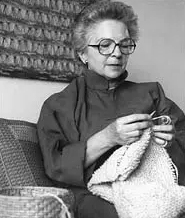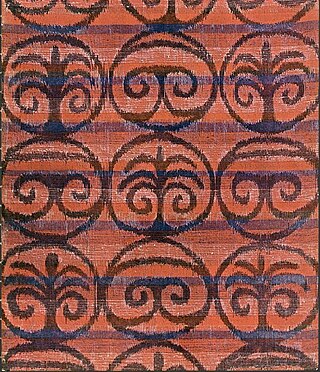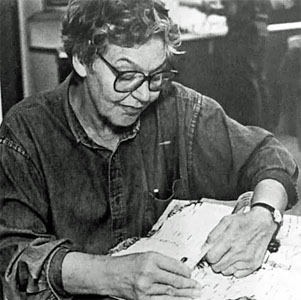Related Research Articles

The Cranbrook Educational Community is an education, research, and public museum complex in Bloomfield Hills, Michigan. This National Historic Landmark was founded in the early 20th century by newspaper mogul George Gough Booth. It consists of Cranbrook Schools, Cranbrook Academy of Art, Cranbrook Art Museum, Cranbrook Institute of Science, and Cranbrook House and Gardens. The founders also built Christ Church Cranbrook as a focal point in order to serve the educational complex. However, the church is a separate entity under the Episcopal Diocese of Michigan. The sprawling 319-acre (1,290,000 m2) campus began as a 174-acre (700,000 m2) farm, purchased in 1904. The organization takes its name from Cranbrook, England, the birthplace of the founder's father.

Mary Walker Phillips, was an American textile artist, author and educator. She revolutionized the craft of hand knitting by exploring knitting as an independent art form. Her hand-knit tapestries and other creative pieces are exhibited in museums in the U.S. and Europe. She was honored as a fellow by the American Craft Council (ACC) in 1978.

Ed Rossbach was an American fiber artist. His career began with ceramics and weaving in the 1940s, but evolved over the next decade into basket making, as he experimented playfully with traditional techniques and nontraditional materials such as plastic and newspaper.
Chunghi Choo is a jewelry designer and metalsmith who was born in Incheon, Korea in 1938. She received a BFA degree from Ewha Womans University in Seoul, Korea, where she majored in Oriental painting and studied philosophy of Oriental art and Chinese brush calligraphy. She moved to the United States in 1961 to study metalsmithing, weaving, and ceramics at Cranbrook Academy of Art in Bloomfield Hills, Michigan, where she received an MFA in 1965.
Stanley Lechtzin is an American artist, jeweler, metalsmith and educator. He is noted for his work in electroforming and computer aided design (CAD) and computer aided manufacture (CAM). He has taught at Temple University in the Tyler School of Art and Architecture, from 1962.
Polly Barton is an American textile artist.

Alice Kagawa Parrott was a Japanese American fiber artist and ceramicist. She spent most of her adult life in Santa Fe, New Mexico, where she established a reputation as one of the country's most important weavers, and opened one of Santa Fe's first shops devoted weaving and crafts.

Marianne Strengell was an influential Finnish-American Modernist textile designer in the twentieth century. Strengell was a professor at Cranbrook Academy of Art from 1937 to 1942, and she served as department head from 1942 to 1962. She was able to translate hand-woven patterns for mechanized production, and pioneered the use of synthetic fibers.
Lola Brooks is an artist, metalsmith, and educator who specializes in jewelry. Brooks' works have been shown at places such as the National Ornamental Metal Museum, The Society of Arts and Crafts, Cleveland Museum of Natural History, the Museum of Craft and Folk Art, and was included in the Talente exhibition in 1996. She has created works that are part of the permanent collection of the Museum of Art and Design, Yale Art Gallery, and the Metropolitan Museum of Art.
Myra Mimlitsch-Gray is an American metalsmith, artist, critic, and educator living and working in Stone Ridge, New York. Mimlitsch-Gray's work has been shown nationally at such venues as the John Michael Kohler Arts Center, Museum of the City of New York, Metropolitan Museum of Art, Cooper-Hewitt Smithsonian Design Museum, and Museum of Arts and Design. Her work has shown internationally at such venues as the Middlesbrough Institute of Modern Art, Stadtisches Museum Gottingen, and the Victoria and Albert Museum, and is held in public and private collections in the U.S, Europe, and Asia.

John Parker Glick was an American ceramicist. Though open to artistic experimentation, Glick was most influenced by the styles and aesthetics of Asian pottery—an inspiration that shows in his use of decorative patterns and glaze choices. His experience working with ceramics led him to publish several articles about the craft. In addition to producing pottery, Glick began making "landscape oriented" wall panels during the latter part of his career. Known as "the people's potter," he is primarily remembered for his contributions to art and the field of ceramics.

Azalea Thorpe was a Scottish-born American weaver and textile designer. Known for her innovative experimentation with both natural and synthetic materials, Thorpe was a featured instructor and lecturer throughout the United States. She has weavings in the permanent collection of the Victoria and Albert Museum. An annual award given in her honor is presented by the Institute of American Indian Arts for fiber arts.
Joan Livingstone is an American contemporary artist, educator, curator, and author based in Chicago. She creates sculptural objects, installations, prints, and collages that reference the human body and bodily experience.

Barbara Cooper is an American artist whose practice encompasses abstract sculpture, public and installation art, drawing and set design. She is most known for her sculpture, which emphasizes process, handcraft, and its basis in natural forms and processes of transformation, such as growth, protection and regeneration. Critic Polly Ullrich writes that "Cooper's hand-intensive art is an art of condensation" that takes "the flow of time and growth as a subject"; that quality often leads writers to align Cooper with postminimalism. John Brunetti describes her work as "sinuous, tactile sculptures [that] quietly juxtapose conceptual and formal dichotomies, among them the organic and man-made, the feminine and the masculine, movement and stasis."

Dorothy Laverne Meredith was an American artist and educator. She was known for her fiber art and abstract watercolor paintings.

Lillian Wolock Elliott was an American fiber artist, and textile designer. She is known for her innovative basket craft.
Gerhardt Gunther Knodel, is an American contemporary textile artist, academic administrator, and educator. He was the head of the fiber arts department at Cranbrook Academy of Art from 1970 to 1997, and also served as the school director from 1997 to 2007. In 2016, he was named a fellow of the American Craft Council (ACC).
Jane Gottlieb Sauer is an American fiber artist, sculptor, gallerist, and educator. She is known for her abstract waxed linen sculptures, sometimes referred to as "closed baskets". Saur founded the Textile Art Alliance; and formerly owned the Jane Sauer Gallery (2005–2013) in Santa Fe, New Mexico.
Sherri Smith is an American fiber and textile artist, weaver, sculptor, and educator. She is one of the pioneers within the field of fiber art since the late 1960s. Smith taught for many years at the University of Michigan (UMich) in Ann Arbor, where she is the Catherine B. Heller Collegiate Professor Emerita. In 2012, she was named a fellow of the American Craft Council (ACC).
References
- ↑ Haddad, Natalie; Zastudil, Nancy (2023-09-10). "Jane Lackey's String Theory". Hyperallergic . Retrieved 2024-01-11.
- 1 2 3 4 5 "Jane Lackey". American Craft Council (ACC). Retrieved 2024-01-11.
- 1 2 "Jane Lackey". Tamarind Institute . Retrieved 2024-01-11.
- ↑ Wittkopp, Gregory (2007). Hot House: Expanding the Field of Fiber at Cranbrook, 1970-2007. Cranbrook Art Museum. p. 70. ISBN 978-0-9668577-6-4.
- ↑ Retzer, John Porter (1986). Fiber R/evolution: Exhibition. Milwaukee Art Museum. p. 100.
- ↑ Multiplicity in Clay, Metal, Fiber: July 7-September 23, 1984. Skidmore College Art Center. 1984.
- ↑ "camo-folder". Detroit Institute of Arts Museum (DIA). Retrieved 2024-01-11.